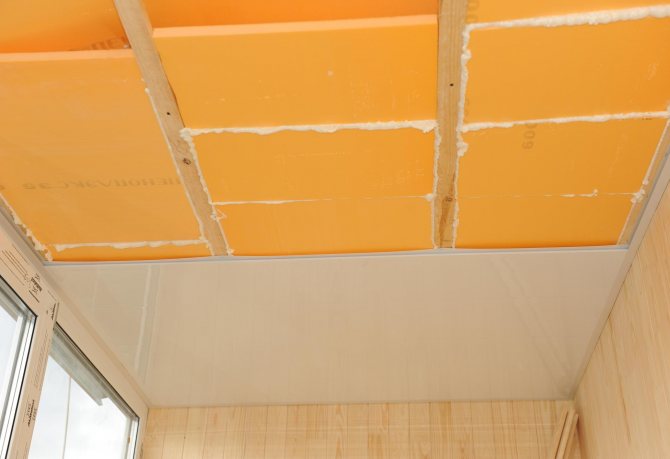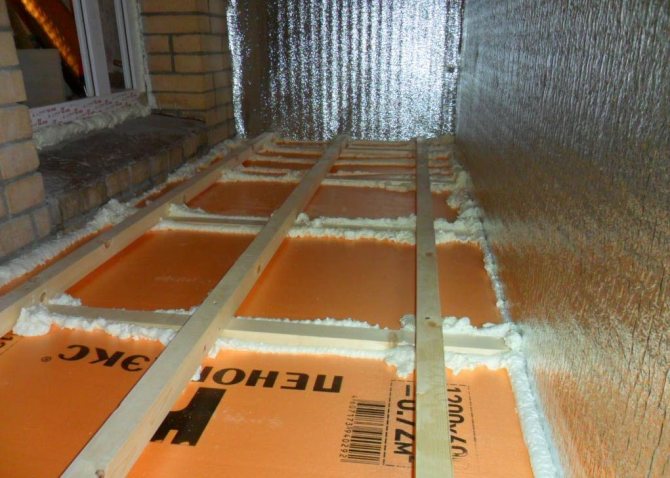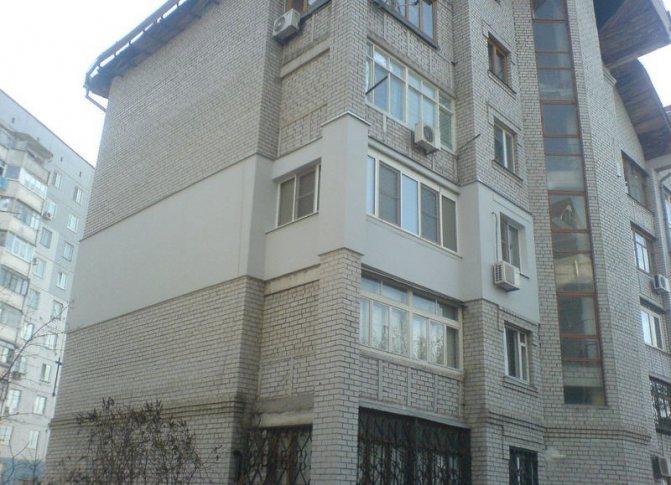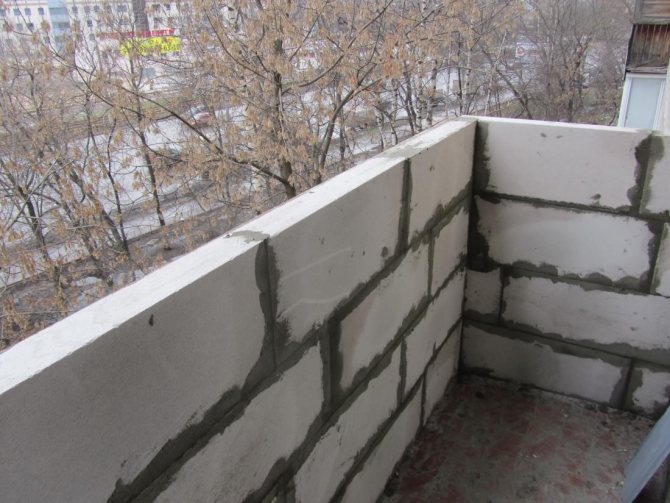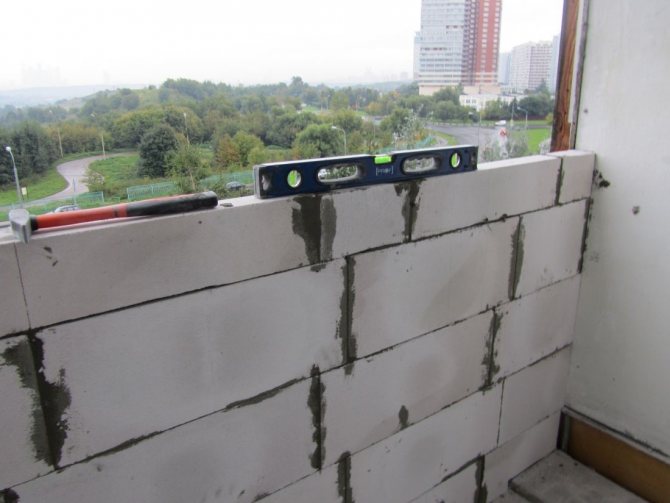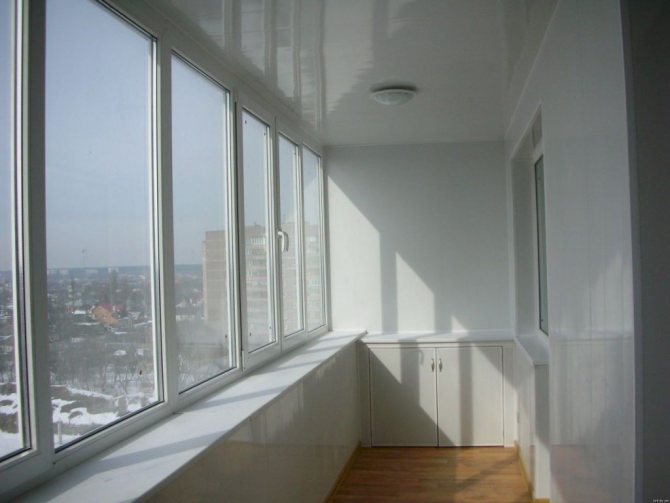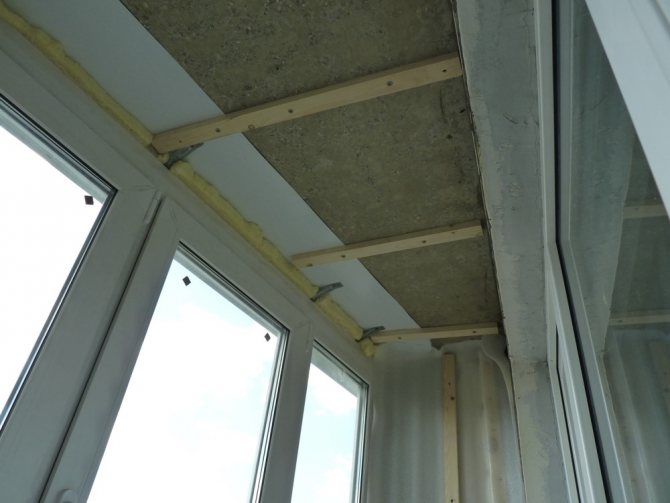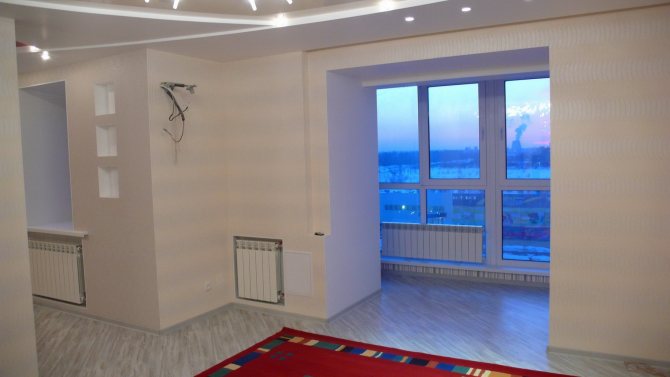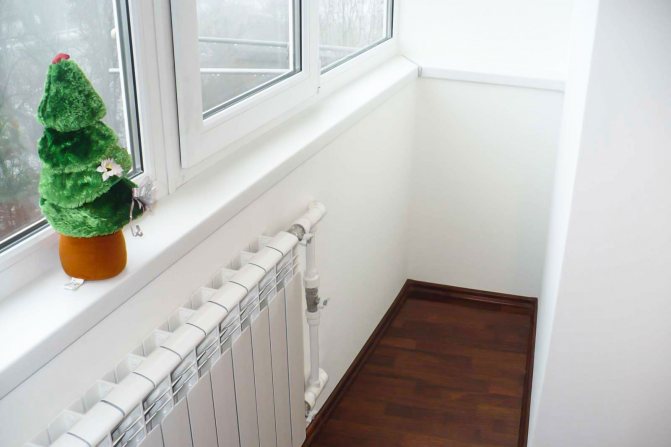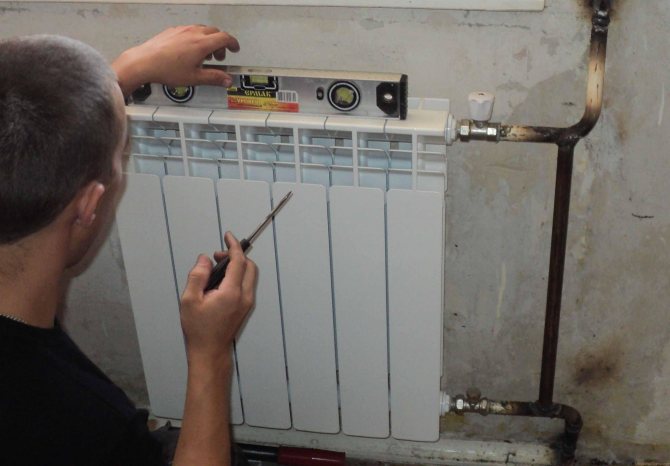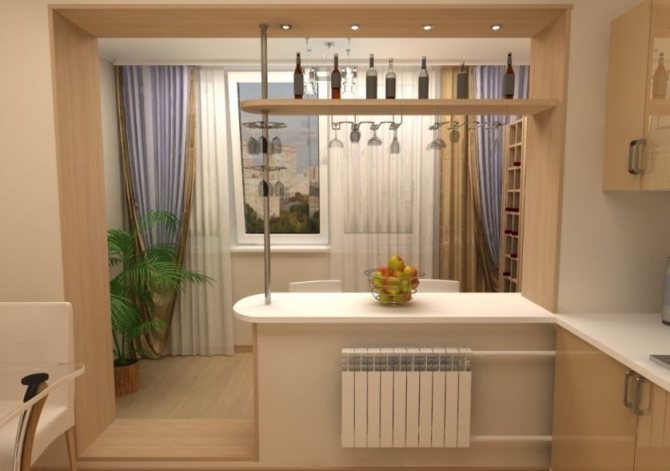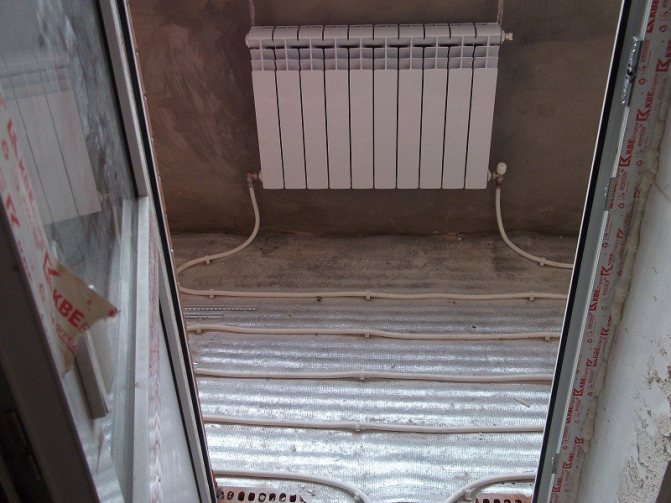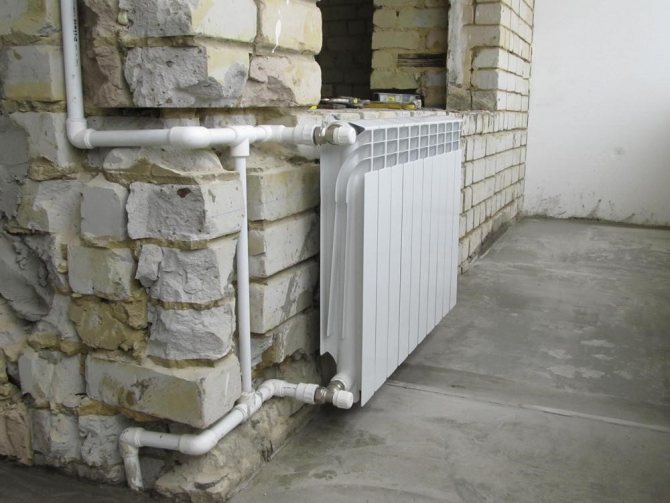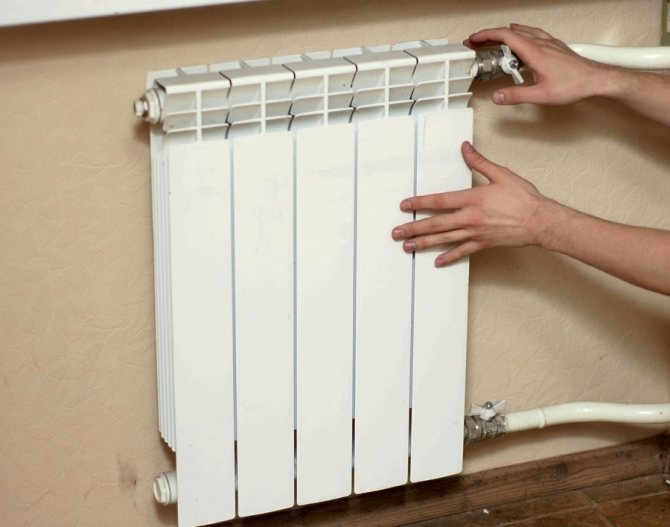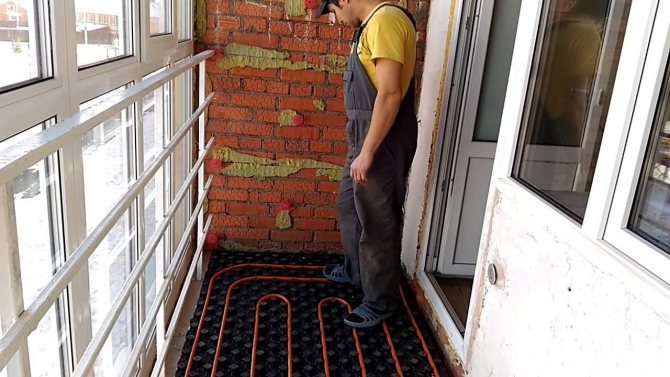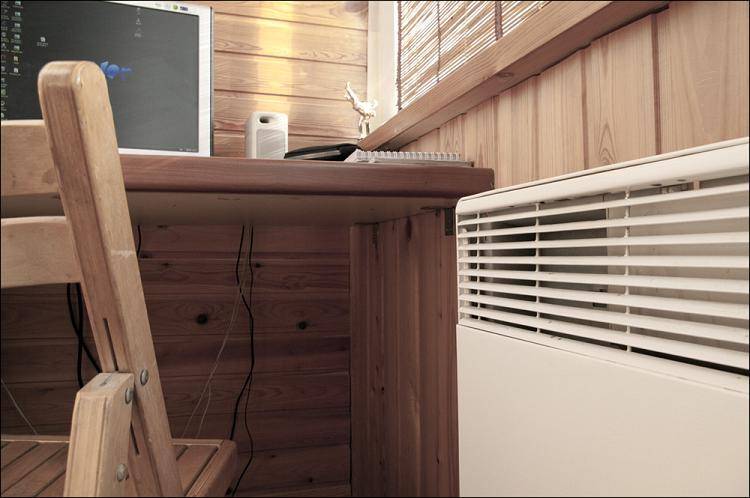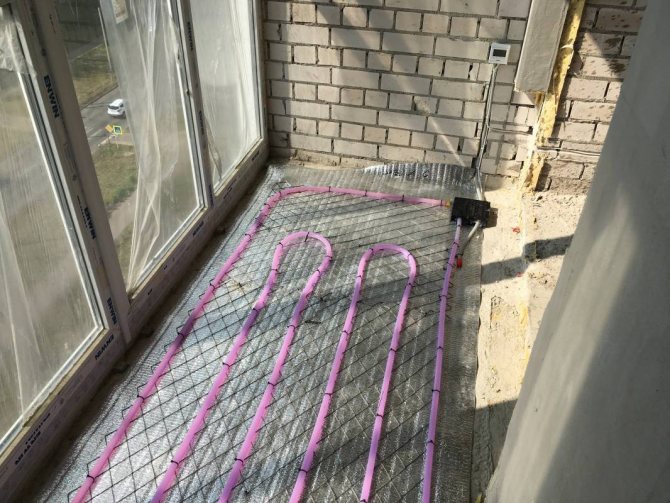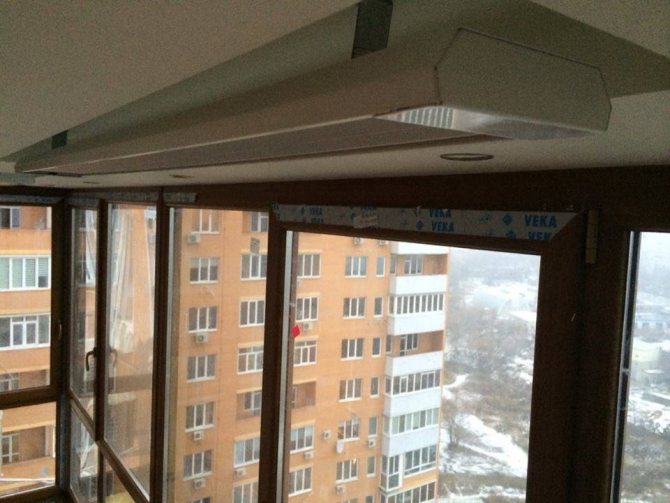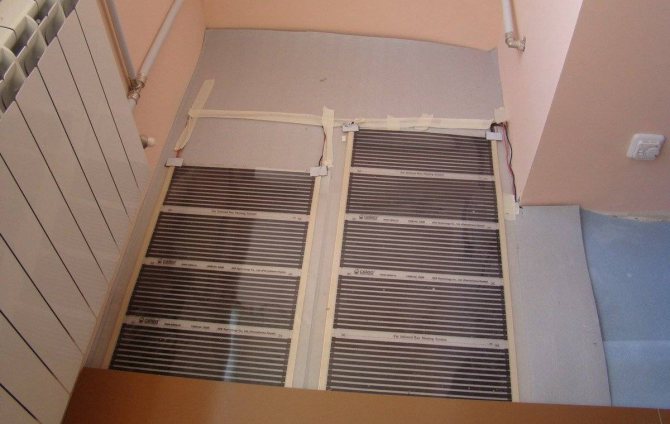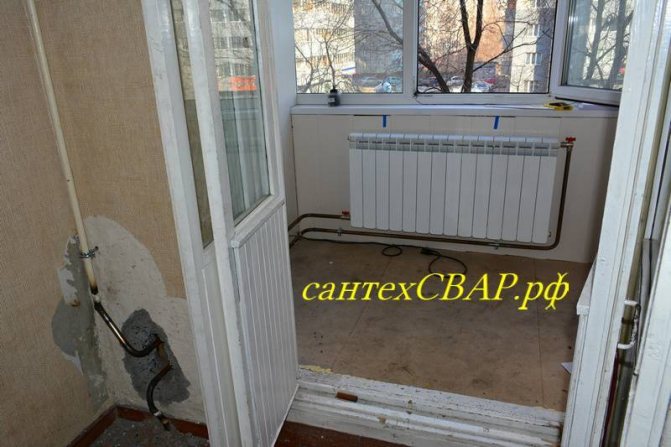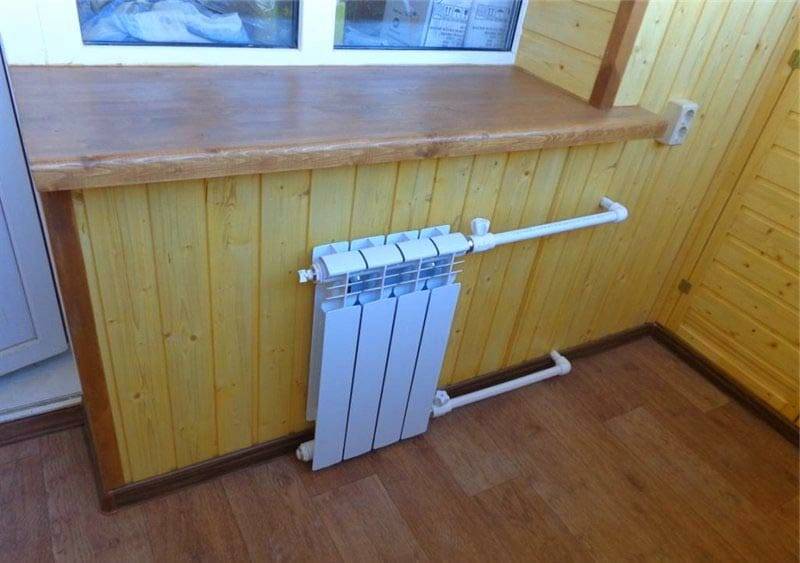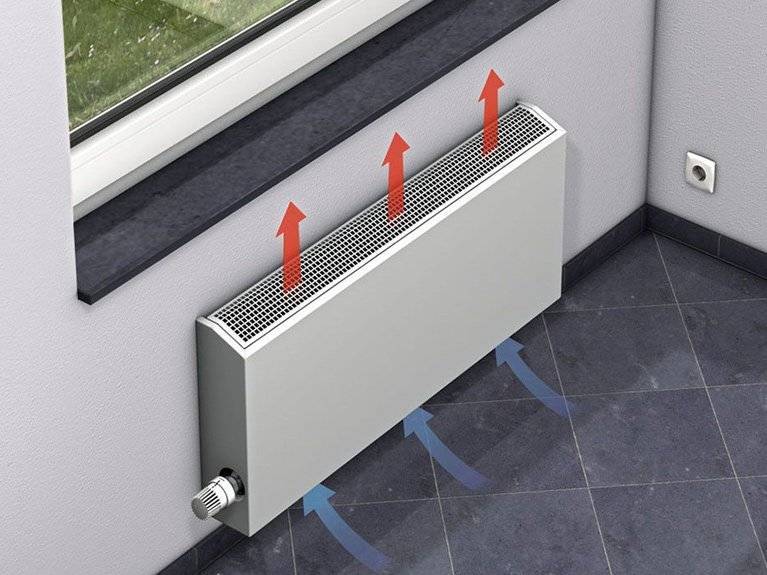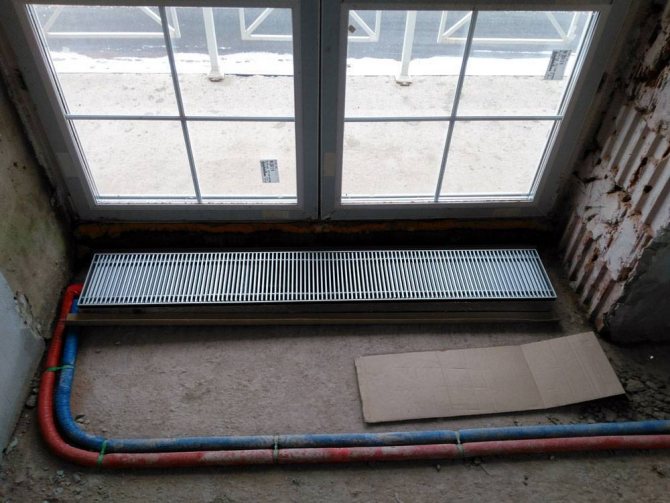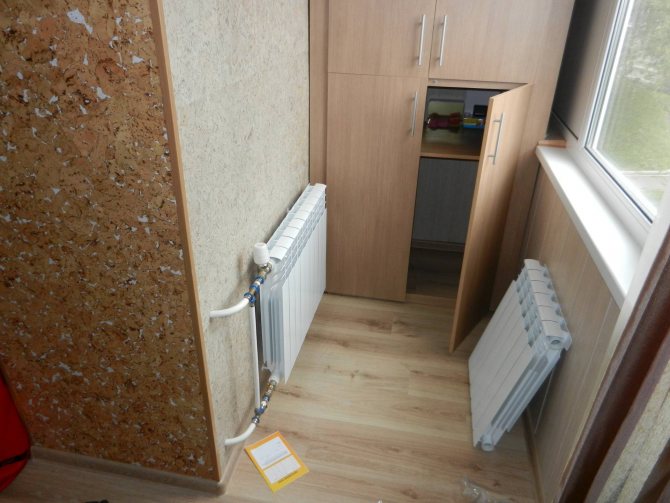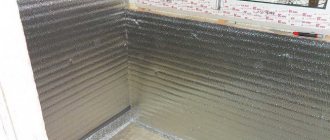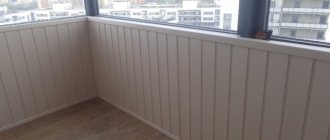Home »Equipment» Heating radiators
In the conditions of a small living space of an apartment building, there is no extra space. Recently, it has become fashionable to use a balcony as a full-fledged room (a study or a place to relax). The practicality of such a solution is difficult to overestimate, but it is important to think over the heating of the loggia, otherwise the whole idea will go to the bottom.
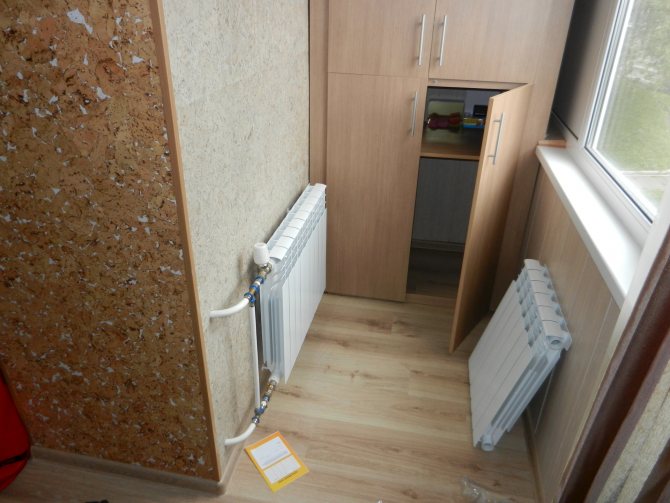
Installation
Installation, transfer and replacement of batteries is best done during the summer, when there is no water in the system. During the heating season, before carrying out work, you need to obtain permission to disconnect from the network from the service company (not free of charge), close the riser at a strictly permitted time (which the neighbors will clearly not approve).
Carrying out such work requires professional training and the availability of tools.
Particular attention should be paid to sealing all joints - this will determine the reliability of the system.
Basic rules and requirements
For good heat dissipation, the following distances and conditions must be met:
- from the top of the battery to the window sill at least 10 cm;
- from the bottom of the battery to the floor at least 12 cm;
- from the wall at least 2 cm;
- the window sill should not overlap the radiator;
- the slope of the supply pipes should be 0.5 - 1 cm for each running meter;
- the radiator must be located strictly in the vertical and horizontal planes - this is checked by the level;
- try to avoid a large number of pipe bends, as this can lead to the formation of air locks and reduce the efficiency of the system;
- it is advisable to install a jumper with a tap - this will allow you to regulate the flow of the coolant and the temperature in the room.
The order of work
- Dismantle the old radiator in the room. It is also necessary to cut the pipes at a distance of 10 cm from the connection points - if you decide on such a redevelopment, then it makes sense to replace the liner at the same time.
- Make holes in the wall or balcony partition through which the pipes connecting the radiator and the riser will pass.
- Pass pipes with threaded threads through the holes so that they go 8 - 10 cm into the room.
- Install all the connecting elements (fittings, connections) from the side of the room in sequence. Parts of the correct dimensions must be threaded.
- Mark the battery attachment point. Install and secure the brackets.
- Mount the battery, adjust the correctness of the hinge using a level.
- Install lintels, channels for water inlet and outlet from the side of the balcony. Install the Mayevsky valve for air release.
- Connect to the general system and check the operation of the radiator.
When it comes to heating an attached loggia in an apartment building, in most cases it makes sense to consider other options: underfloor heating, ceiling infrared heating. Such systems are no less effective, and the installation does not require approvals.
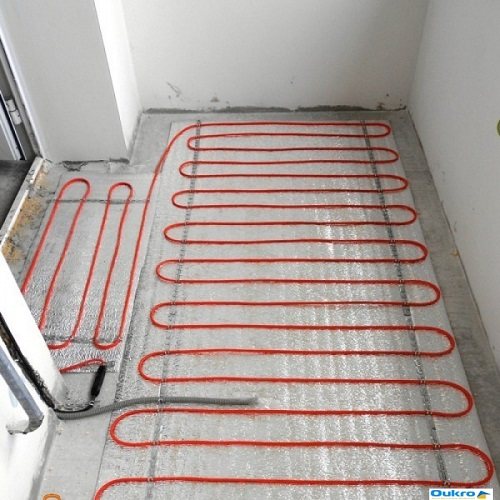

Electric underfloor heating cable system
Features of installing heating on the balcony
Tapping by means of a threaded connection
To connect the branch pipe to the radiator, it is preferable to use polypropylene pipes. They are lightweight, durable and last up to 50 years. You can also use flexible metal hoses, pipes made of metal-plastic, fiberglass-reinforced plastic.
If the shortest route for laying a new heating circuit passes through the wall (for example, a new battery is hung on the front wall opposite the old one installed in the room), then a hole in the wall should be made 6-8 mm larger than the diameter of the outlet pipe with a puncher. After laying the pipe, blow out the formed gap with polyurethane foam.
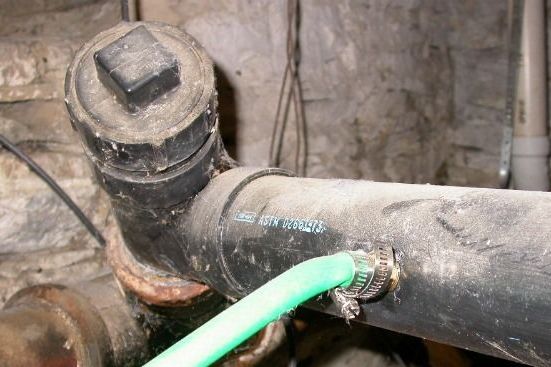

Polypropylene branch pipe
If you are using long plastic pipes, then lay them along the walls and do not forget to fasten, for example, with clamps nailed to the wall with dowels. Otherwise, the pipes will sag strongly over time, the sealing of the joints will be broken.
The connection of polypropylene pipes should be carried out by means of fittings, welding. They are welded using a soldering iron with special nozzles. Welding temperature - 240-260 degrees.
If you use reinforced pipes, do not forget to remove the reinforcement (foil gasket) from the end to a depth of 1-2 mm before welding. It is best to do this with a special tool - a facing tool.
Points to consider when transferring
The first and main obstacle to such a solution is the Housing Code of the Russian Federation, which categorically prohibits the transfer of engineering communications to balconies and loggias, including heating batteries. In very rare cases, it is possible to obtain official legal permission for such redevelopment in apartment buildings. But the owners of private houses can carry out this type of work quite calmly.
The second important factor to consider is the condition of the outer walls. It makes sense to install any heating system in well-insulated areas, otherwise no method will be effective. In addition, if the wall freezes through, then there is a high probability of water freezing and a radiator breakthrough. The consequences are not only a fine for illegal redevelopment, but also payment for repairs of the apartments located below.
Balcony insulation technology
Of course, before choosing a heater and installing it, the balcony must be glazed and insulated. Complete isolation is needed in cases where the premises are used constantly.
The procedure for insulating a balcony or loggia
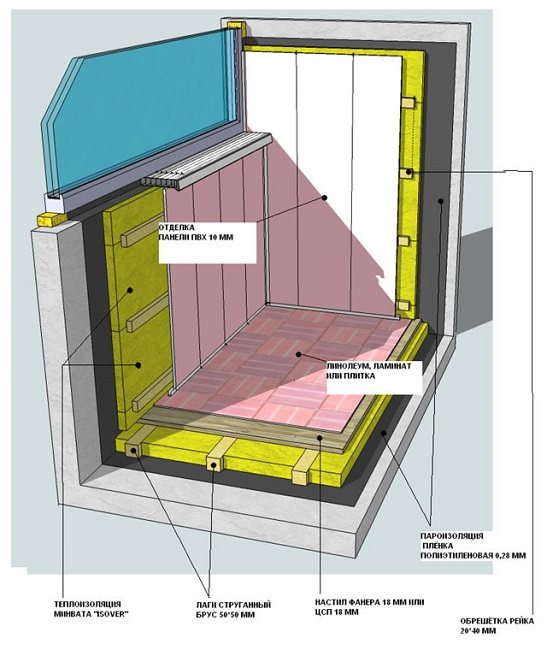

To begin with, let's figure out in what sequence the balcony or loggia is insulated. In order it is necessary:
- Dismantle the old topcoat, panels, etc .;
- Clean the slabs and walls of the balcony;
- Foam all gaps and crevices, if any. After the foam dries, its excess must be cut off, and all the debris must be swept away;
- If there is no glazing, it must be installed at this stage. For the best result of insulation, it is better to use high-quality double-glazed windows and entrust the work of installing them to professionals;
- Carry out waterproofing. The best for this purpose are funds with penetrating ability, such as "Aquaton". The mixture is applied either with a roller or sprayed on surfaces (which is preferable, since all hard-to-reach areas will be processed);
- Lay a layer of insulation. The styling technology will differ depending on the material chosen;
- Install vapor barrier. It can be penofol or special membranes. Foil materials will help not only create the right microclimate in the room, but also keep it warm;
- Finish the surfaces.
It should be borne in mind that if the balcony is old, it is imperative to check the condition of its floors before starting work. If you are not sure about the reliability of the structure, it is better to play it safe and carry out a major overhaul.
The best heaters for the balcony
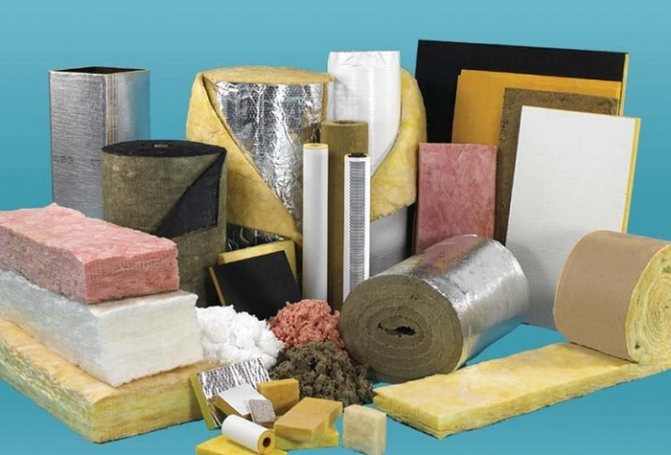

Now let's talk about insulation for the balcony. It is worth focusing on this, since not all types of insulation are suitable for this room. Firstly, the material should not be heavy, and secondly, you need to save space as much as possible.
TOP 5 best heaters for balconies and loggias:
- Polyfoam is a cheap, lightweight and durable material. You can easily match the thickness of the sheet to the size of your balcony. But you should be careful in terms of fire safety, since the foam is easily flammable;
- Izolon is a material with a foil layer, which also has soundproofing properties. The only drawback is the relatively high price;
- Penoplex (extruded polystyrene foam) is one of the most durable insulation materials. It has many advantages, but it is also worth it;
- Mineral wool is an environmentally friendly material that is easy to install. It should be used only on waterproofed balconies;
- Expanded clay is an excellent option for floor insulation. Lightweight, soundproof, fireproof, fully environmentally friendly material.
Transferring the battery to the loggia
Important: Take out should be done only in the warm season, when the heating is turned off. Work is carried out only after glazing the loggia and carrying out work on its insulation
The marking of the place where the battery will be installed is carried out. It should be close to the load-bearing wall, but at some distance from the door.
If the area of the loggia is about 6 sq. m and less, then 3-4 sections of the battery are needed to heat it.
- Grinder, puncher and file.
- Steel plates.
- Polyurethane foam and cement mortar (1 part of cement to 3 parts of sand).
At the installation site of the battery, the grinder makes small indentations for the installation of the entire structure.
Opposite the points of the battery tie-in on the main pipe, the wall is punched through with a perforator. The holes made must be enlarged to the size of the pipe diameter +50 mm.
- Battery, pipes and fittings.
- Sealant, die and vice.
- Welding machine and tape measure.
On the main pipe, a cut is made with a grinder and an external thread, on which fittings with an additional branch are installed.
Pipes with a projection of 9 cm are led out through the wall. At their ends, threads are similarly made for attaching corner fittings.
After these works, the installation of vertical pipes that supply and drain water from the battery is carried out - they are screwed into ready-made fittings.
The detailed process of installing the battery on the loggia can be seen in the video:
The choice of insulation for internal surfaces
After glazing, the interior surfaces are insulated on the balcony: ceiling, side walls, parapet, floor. Only the back wall, which borders the room, is not subject to thermal insulation.
The rear wall is not specially insulated for heat transfer between the balcony and the inner living area.
The main criteria in choosing a heater are the dimensions and thermal insulation characteristics of the material. For the insulation of the balcony, polystyrene, extruded polystyrene foam and isolon are mainly used.
Expanded polystyrene foam
For more than half a century it has been used to insulate building objects. Having 98% of the air in closed polystyrene cells, the foam has a low mass, therefore it does not load the insulated structure.
Styrofoam specifications:
- density: 25 kg / m³;
- water absorption in 24 hours: no more than 2%;
- thermal conductivity: 0.038 W / m² · ° С;
- operating temperature range: -60 ÷ +80 ° С.
To make a warm balcony, a 50 mm thick foam sheet is used for the walls and ceiling, the heat transfer resistance of which is 1 m2 · ° С / W. The sheets are fixed with special glue or plastic fungi, the joints are treated with polyurethane foam.
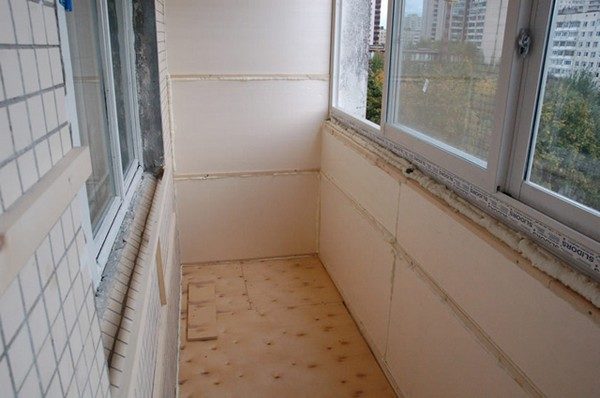

Polyfoam is the most affordable insulation for a balcony
Read about the technology of balcony insulation with foam plastic in the detailed instructions.
Extruded polystyrene foam
Like styrofoam, extruded polystyrene foam is made from polystyrene, so the materials are similar in appearance. The difference lies in the production technology.Thanks to the extrusion method, a polymer product with a dense structure is obtained, which increases its strength and thermal insulation properties.
Technical characteristics of extruded polystyrene foam:
- density: 35-45 kg / m³;
- water absorption in 24 hours: no more than 0.2%;
- thermal conductivity: 0.030 W / m² · ° С;
- operating temperature range: -60 ÷ +80 ° С.
When installing extruded polystyrene foam, the insulation layer is thinner compared to the use of foam. It is allowed to install sheets with a thickness of 30 mm, which have almost the same thermal resistance coefficient as 50 mm foam.
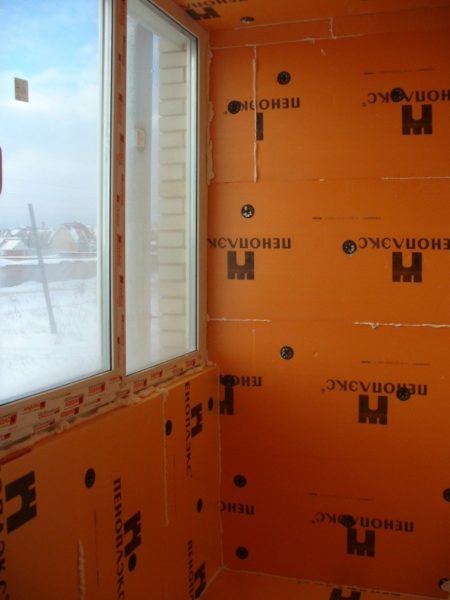

Extruded polystyrene foam allows you to create a uniform insulation contour on the balcony
"Extruder" is dense, calmly transfers the weight of a person. it is used for walls, ceilings, for floor insulation without additional lathing.
How to insulate a loggia with Penopex (modern insulation based on extruded polystyrene foam), see the video tutorial:
Foamed polyethylene
Elastic polyethylene foam is well known to tourists; rugs for rest and overnight are made of this material. Even with a small coating thickness, polyethylene foam is an excellent heat insulator. Builders use the material when arranging warm balconies and loggias.
Foamed polyethylene specifications:
- density: 33 kg / m³;
- water absorption in 24 hours: no more than 3%;
- thermal conductivity: 0.033 W / m² · ° С;
- operating temperature range: -80 ÷ +95 ° С.
The main advantage of polyethylene foam over other heaters is size. Roll material with a thickness of only 10 mm is able to provide heat transfer resistance at the level of 0.97 m² · ° С / W, which is enough for high-quality surface insulation.
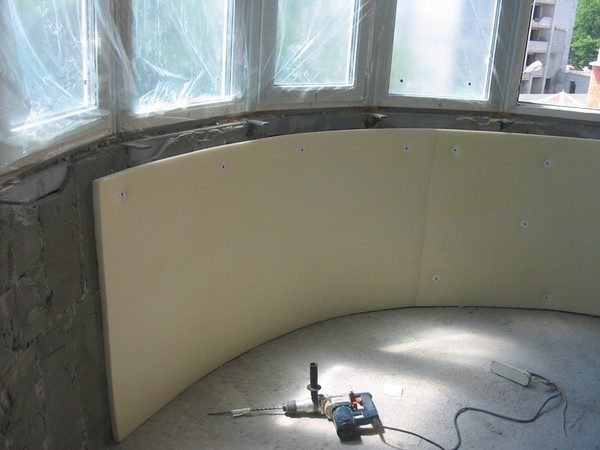

Foamed polyethylene on the balcony is saving internal space
What to consider when choosing a heater


To choose the right heater for the balcony, you should take into account the following technical features:
The power of the device. The speed of heating the air in the room depends on it.
Homeowners need to remember that powerful appliances require careful handling, they cannot be plugged into a network with a TV, washing machine and other similar equipment, they consume a lot of electricity. If you do not have the ability to connect them, take simpler counterparts. Device mounting options
Before ordering convectors or a "warm floor" system, think about whether you can install and connect it correctly. If not, it is advisable to choose a simpler version of electric heaters: infrared lamp, fan heater. Functional features of the premises. If you need to provide heating of the balcony in winter for a couple of days, it makes no sense to install expensive heating equipment on it, an ordinary fan heater will be enough. If the balcony is used as a separate room, it is better to install a "warm floor" system or convectors on it. Work safety. Do not use high temperature appliances if you have curious pets or small children. In such cases, it is better to choose the safest options: infrared heaters or a "warm floor" system.
If you cannot decide which heating equipment to use for your balcony, contact a specialist on this matter. They will take into account all the features of the operation of this room and select the most suitable option for your budget.
Convection heater
A convector heater (thermal panel) works on a principle similar to a fan. But you will not hear the noise from him, no matter how hard you try.
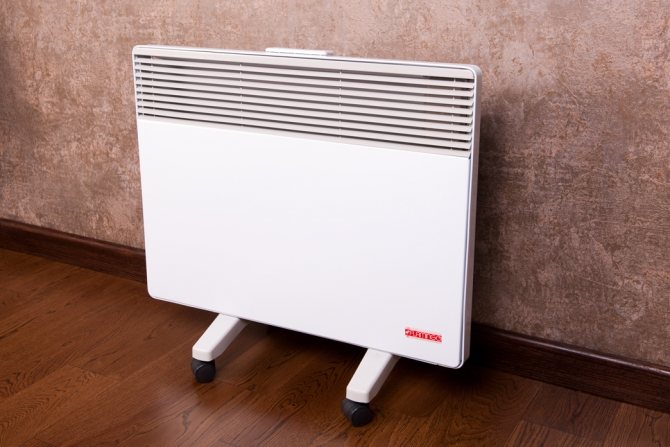

The convector can be left on 24 hours a day


Convector working principle
In general, the convector has all the advantages of a 21st century heater.Heats up quickly, turns off itself when necessary, just installs. And you can place it wherever your heart desires: on the floor, on the wall and even on the ceiling! Depending on which part of the balcony needs to be heated.
but the convector has its disadvantages... Firstly, it dries the air, and this can cause a headache. Secondly, like all electric heaters, it consumes a lot of electricity. Heating 1 m2 of balcony per month in Moscow takes 324 rubles at least! This is if the balcony is well insulated. If not, the costs will increase many times.
Sticking to the letter of the Law
Carrying out the removal of the battery to the balcony without drawing up the appropriate documentation, you need to understand that after this event you run the risk of "running into trouble", the most minimal of which will be the imposition of a fine on you.
But, in this case, the matter will not be limited to the payment of a fine. You will have to either dismantle the battery installed outside the apartment, or, having received written confirmation from all the owners of the living space, prove in court that such an alteration is safe for the heating system and does not affect the quality of living in the house of other residents.
Based on your application, the court will make an appropriate decision. He can authorize the changes made by you, after which they will be included in the Technical plan of the apartment or recognize them as illegal. Then you will have to dismantle the installed equipment within the specified time frame.
If you are in doubt about the need to move the radiator, we recommend that you familiarize yourself with the alternative heating option. Read how to make a warm floor on a balcony with your own hands on our website. The article discusses the features of all variants of this system.
It is also possible to use ceiling infrared heating on the balcony. It has several advantages and is much easier to install.
But whichever option you choose, in any case, heating will only make sense if the room is well insulated. We described how to do it right here.
We insulate ourselves correctly
The first step for insulating a balcony is covering it with vinyl siding, provided that you have a parapet - an ordinary lattice. Sealing all cracks with polyurethane foam is the next step. And then the glazing. It is preferable to use metal-plastic windows with double-glazed windows for this. Single-chamber ones are not suitable for these purposes, since in severe frost they can be covered with ice on the inside.
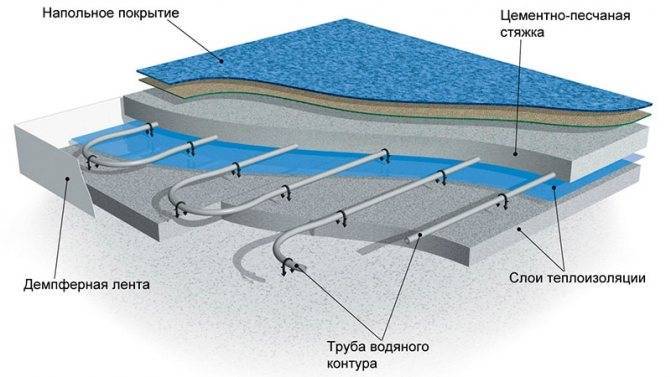

Scheme of work on the installation of a water floor on the balcony
Now we insulate the floor
Floor insulation is the next stage of work after the completion of similar operations with walls and ceilings. To do this, it is advisable to use one of the following materials:
- mineral wool;
- expanded clay;
- foam;
- penoplex;
- penofol.
Do-it-yourself floor insulation on the balcony with penoplex
The order of work should be as follows:
- The concrete base of the room is covered with the existing waterproofing material.
- Then wooden logs are laid on the waterproofing.
- After that, the purchased insulation is pressed between the laid logs.
- From above, everything is covered with a vapor barrier film.
- The final stage is laying the sub-floor.
Why is it difficult to get permission
It is difficult to obtain permission to install a central heating radiator on a balcony or loggia for a number of reasons.
Firstly, the central water supply system is designed for a strictly defined number of heating devices (radiators), which is indicated in the technical passport of the house. Therefore, the battery on the balcony is the installation of an additional heating device (radiator) entails a decrease in pressure in the coolant system and, as a consequence, a decrease in its temperature proportionally in all apartments.
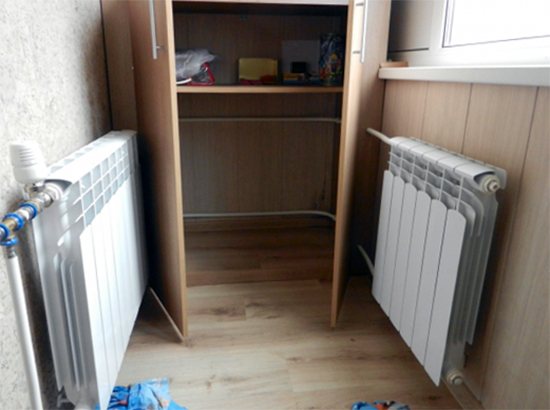

Secondly, neither balconies nor loggias belong to living quarters, and heating of the loggia or balcony is not provided for by any technical standards. Even the most careful insulation of these external structures does not guarantee that the heating radiators brought out on them by their own hands will not defrost when lowered and the heat supply throughout the house will not stop.
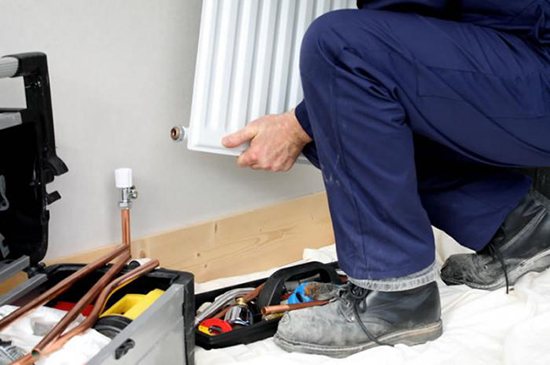

Thirdly, the payment for heating utilities is charged based on the technical passport of the apartment, which specifies the number of radiators installed in it. Installing additional radiators is essentially theft of heat energy from the service organization, just like using electricity or water supply bypassing existing individual meters. Even if you, in any way, manage to bring them to the balcony, having received such a "permit", it will still require changes to all the technical documentation of the apartment building, which you will have to pay at your own expense.


It will also be necessary to make an additional payment for the amount of heat received from the heating radiator brought out to the balcony.
What should be foreseen?
Before proceeding with the installation of heating a balcony or loggia, it is necessary to insulate the room itself. Insulation includes glazing and cladding with insulating material of all internal and, if possible, external walls. Glazing with the help of two-chamber windows or plastic frames will reliably keep the heat on the balcony, competently mounted foam or mineral wool insulation will provide comfortable humidity, air temperature, and thoughtful ventilation will eliminate dampness and condensation.
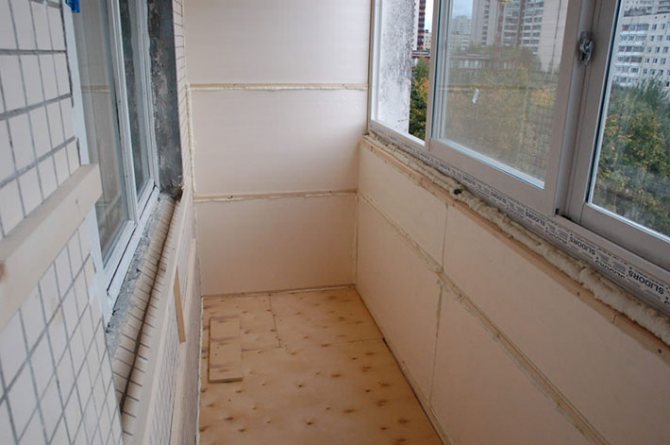

Photo 3. Thermal insulation of the balcony as the first stage
The most time-consuming stage is the work on the insulation of the walls, in particular the floor. But before you make the floor insulation, you must assume which heating option is preferable for your balcony.
Heating on the loggia, how to organize
Installing heating on a loggia is only the first step towards equipping it with a full-fledged living area. Even the most perfect insulation is only able to keep warm, but does not produce it itself. That is why the loggia needs heating. There are several ways to organize heating on the loggia, photo below.
Warm floor
- Electric underfloor heating - contrary to popular belief, it does not consume much energy (180-200 W / sq. M.). Like any electrical appliance, such a warm floor requires the organization of wiring on the loggia. The cost of such heating is quite high, but it quickly pays off due to the reliability and efficiency of the warm floor. Can be installed under all types of flooring, except for floorboards.
- Water heat-insulated floor - ease of installation and low cost of materials make this type of heating in demand. A warm water floor on a loggia can be installed under any cover, but its main drawback is the need to connect to a heat source, which is usually a central heating battery - and this is rarely legal. In addition, leaks are possible, which are extremely difficult to eliminate.
- Infrared underfloor heating is a rather expensive, but effective way of heating a loggia. Film heating elements are installed under the finishing. The principle of operation is to heat surfaces, not air. Among the disadvantages is fragility, so you should not install infrared underfloor heating in areas where heavy furniture will stand. It is best to install such a warm floor under porcelain stoneware, laminate or linoleum.
The advantages of a warm floor are:
- Uniform heating of the entire floor surface.
- Visual lack of battery.
- Saving useful space.
- Providing a comfortable room temperature.
Electric heating
This group of heaters includes:
- Oil heaters.
- Electric fireplace.
- Air conditioning.
- Electric convectors.
The convector is the simplest and most common type of heater for a loggia, but it requires the mandatory installation of an outlet, that is, you first need to supply electricity to the loggia.
For heating a loggia up to 5 sq. m., you can install a 1 kW heater, which will provide uniform and rapid heating of the room. Such heating does not dry out the air, but with constant use it is costly.
Removal of central heating to the loggia
Removing the battery is the most economical, but it has its own significant drawbacks:
- To transfer the battery to the loggia, you will need BTI permission, which is quite difficult to obtain.
- There is a possibility of pipe breakage with serious consequences. This can happen if the heating is temporarily turned off.
Important: The main reason for prohibiting the removal of the battery to the loggia is a decrease in pressure in the heating system, since the number of consumers increases
Good double-glazed windows - warm balconies
When choosing PVC windows, the main criterion is the number of hollow chambers, in a standard set there are from three to five. They prevent the ingress of cold, respectively, the more their number, the better the windows retain heat. The equipment should use special plastic systems. Glazing with this type of windows instead of traditional ones will reduce the heat loss of your home by as much as 30%, prevent drafts and dust. Such a design, made according to new Austrian technologies, will help to make glass-cut balconies with a complex shape.
Portability problems
Asking the question whether it is possible to take out the battery to the loggia, on the one hand, it seems that there is nothing special and complicated in transferring a heating radiator from an adjacent room to this part of the apartment. After all, the balcony itself will be carefully insulated before this procedure is carried out, so there is no need to worry about possible heat losses associated with an increase in the usable area of the room. However, in practice, it is very difficult to implement this idea, if only because such a move is not approved by the Housing Law without obtaining the appropriate permission.
According to paragraph 1 of Article 25 of the Housing Code of the Russian Federation, the transfer of utilities is part of the redevelopment of the living quarters. But balconies, loggias and some other types of premises do not belong to this category. Therefore, the transfer of radiators there is strictly prohibited. The following arguments can be cited as weighty and adequate arguments in favor of this prohibition:
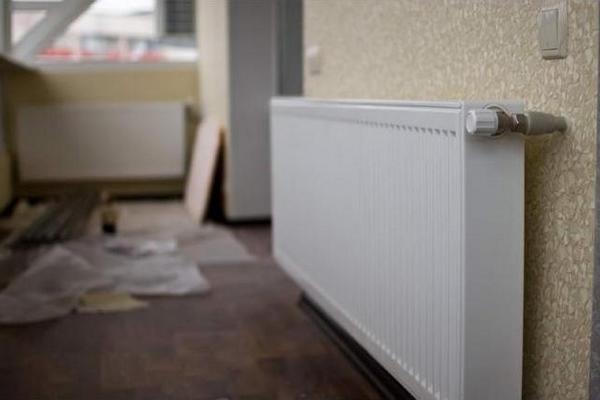

Option for placing a radiator on the balcony
Additional related video
A full range of works - from glazing and insulation to joining the loggia to the room:
The main mistakes of insulation:
Installation of a film underfloor heating on a loggia:
The construction of a warm balcony and loggia is a technologically complex process that includes several key stages. Only trained masters with a sufficient knowledge base and tools can perform such work on a turnkey basis. Therefore, in the absence of the necessary experience, as well as unwillingness to spend money on correcting errors, entrust the installation of glazing, insulation and floor heating to professionals.
YOU MAY ALSO BE INTERESTED IN
How to heat a balcony
Do you need additional heating for the balcony or will it be properly insulated and glazed to cope with the cold? Unfortunately, these measures are not enough to maintain a temperature above 18 degrees on the balcony in winter, that is, comfortable for a person. There are many ways how to make heating on the balcony, we will consider the most common.
Electric convectors
An electric heater can easily replace a central heating battery. The advantages of such heating are:
- Compactness.
- High efficiency.
- The surface temperature does not exceed 60 degrees, therefore the air does not dry out.
- Low power consumption - about 200 W / sq. m.
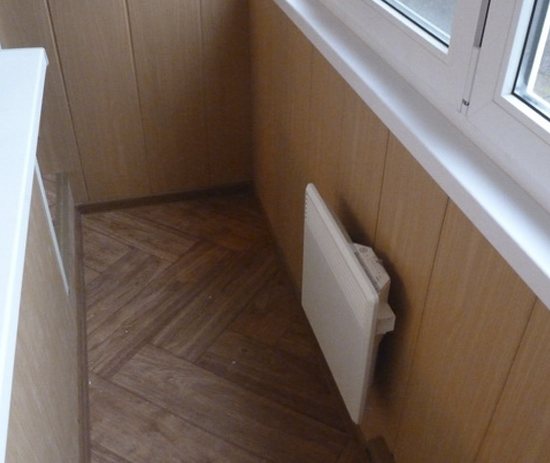

Heating the balcony with a convector
There are several options for how to install the convector: on the floor or on the wall. But air circulation should be taken into account, therefore, the heater on the balcony should be located under the windows to reduce heat loss.
Important: When wall mounting the heater, you should avoid installing the brackets to the wall through the insulation, since the operation of the device can lead to freezing of the mount and destruction of the finish.
To connect the electric convector on the balcony, a separate socket is required, therefore, before installing it, you should take care of the wiring.
Infrared heating
Such heating is unique, since it does not heat the air on the balcony, but the objects on it, which accumulate this heat, which makes it possible to reduce the heating temperature. Thanks to this heating, the air on the balcony does not dry out.
An infrared film acts as a heating element, which can be laid on the floor, photo below, or on walls and ceilings under plaster.
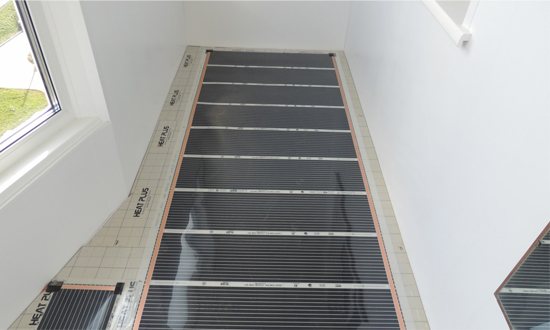

Infrared heating on the balcony will replace the battery
Most often, it is placed on the floor, but you should be careful, as heavy furniture can damage a fairly thin layer. The power consumption of such heating is much lower than in traditional underfloor heating, therefore, it is a very economical option.
Warm floor
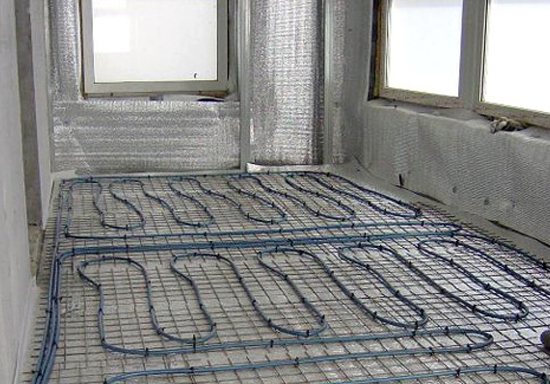

Do-it-yourself warm floor
Despite the rather high cost of both materials and installation, underfloor heating is quite economical - 150-200 W / sq. m., are durable and quickly pay off. This type of heating can be installed under almost any floor covering, with the exception of natural wood, which is not designed for temperature extremes.
Water heating
The simplest and most common way to heat a balcony is to take it out on the central heating batteries. But it is worth saying that recently, the output of the radiator to the balcony has been prohibited. This happened due to the fact that when installing batteries on the balcony, many residents do not receive additional heat.
Important: Incorrect installation of the battery can lead to a pipe break and flooding of neighbors, and if such heating is not agreed - a fine and legal proceedings.
Despite all the prohibitions, apartment owners still install central heating batteries on the loggias, since this is practically not associated with costs, except for the installation itself, and the heating is complete.
Electric floor heating
Electric heating of a balcony is more expensive and more reliable than water heating. Installation is almost indistinguishable from water systems. The only difference is that the electric floor must be connected to the power supply.
Benefits:
- durability;
- easy installation;
- precise temperature control.
Disadvantages:
- high price;
- needs a stable mains voltage;
Conclusion: a durable system for apartments, small suburban areas.
Electric underfloor heating on the balcony is of two types:
- cable;
- infrared.
The latter type is more modern, but it is not devoid of its shortcomings.
Cable electric heating
The heating element of such a system is a one- or two-core wire that has two layers of insulation. Cable heating on the balcony is not very economical.
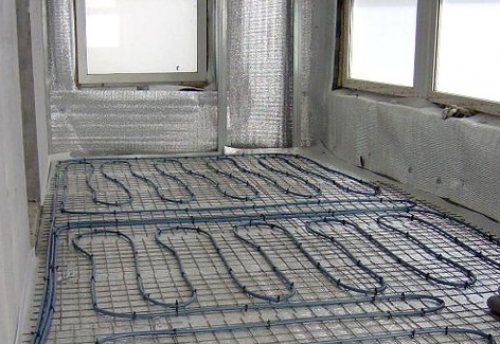

Infrared electric heating
Thin thermal films of infrared heating systems consist of graphite strips isolated from each other and from the environment. Such heating is 20% more economical than cable analogs, completely safe, but its service life is no more than 15 years.
Option Oh Lucky
If you nevertheless decide to seek permission to transfer the central heating battery to the balcony, then you need to:
- to carry out engineering calculations of the thermal conductivity of the balcony insulation;
- get the conclusion of a licensed specialist that it is impossible to freeze the battery on the balcony;
- carry out insulation and glazing of the balcony;
- get permission to transfer;
- choose and approve a diagram of how to make heating;
- installation of batteries and connection to the heating system.
Tip: If you plan to do heating the balcony with your own hands, then before removing the batteries, it is recommended to paste over the wall under the heater with a foil screen, this will exclude heat loss for heating the wall.
Section calculation
According to SNiP standards, in order to avoid freezing of the heating system, mainly in the corners, the battery should be at least half the length of the window in length. In addition, each type of battery has its own characteristics of heat transfer for 1 section:
- aluminum for 2m 2 of the heated area;
- bimetal 1.5m 2.
Step by step instructions on how to install batteries:
- We make markings for radiators. The distance from the window sill to the upper part is less than 100 mm, from the bottom to the floor - not less than 120 mm, from 20 mm or more from the wall.
- Brackets are installed, the main weight must be supported by the upper mounts. Up to 12 sections - 2 on the top, 1 on the bottom to eliminate the movement of the bottom. If the battery is larger, then additional top mounts are required.
- We hang up the batteries, check the level of the horizons and verticals.
Connection
To avoid the formation of an air lock, make sure that there are no kinks of the lower pipe in the direction from the radiator upwards, and the lower pipe in the opposite direction.
How to put the batteries:
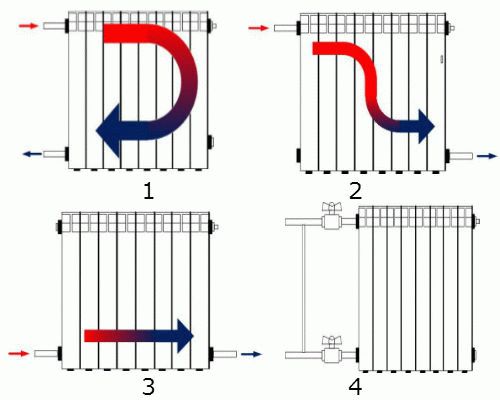

Installing the battery on the balcony
- Lateral.
- Diagonal.
- Lower.
- With a boy-pass to regulate the heating agent supply.
If the battery has 12 sections or more, a diagonal heating connection is more advisable.
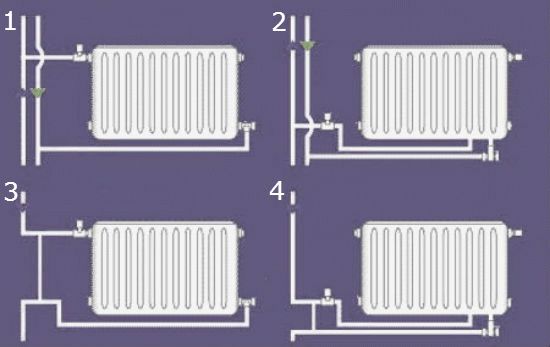

Battery connection diagram for central heating system
Connection diagram to the central heating system:
- Two-pipe side connection.
- Two-pipe bottom connection.
- One-pipe lateral.
- Single tube bottom.
Video on how to install the battery
But if you decide to connect the heating of the balcony or loggia with your own hands, then first of all, turn off the supply of the heater.
Important: If there is no shut-off valve, then the batteries should be installed outside the heating season.
- Cut off the old battery.
- Install the inlet valve.
- Screw the connecting pipe into the battery and into the tap through the fittings.
Tip: Use fum-tape or tow to seal and tight the joints.
Connecting the battery to the central heating system is the most crucial stage in the work, it is better to contact certified specialists, then in case of leaks they will be responsible.
The article was written based on materials from the sites: schoolremont.ru, klivent.biz, balkonsami.ru, oknanagoda.com, house-lab.ru.
conclusions
A balcony with a heater can become a full-fledged room. You can conduct heat into it in various ways: simple and exotic. When using solar panels for an apartment, all electricity for heating will be free, but installation will be expensive. The innovative warm skirting board is ideal for small balconies. The simplest heating option is a conventional battery, but for its installation it will be necessary to obtain permission from the BTI.
YouTube responded with an error: The request cannot be completed because you have exceeded your quota.
- Similar posts
- What can be used to paint central heating batteries?
- How to repair bimetallic heating radiators with your own hands?
- How to choose central heating batteries?
- How to repair a cast-iron heating radiator with your own hands?
- What is the norm for the water temperature in central heating batteries?
- Characteristics of an infrared heating radiator
Water heat-insulated floor heating of a loggia
How to heat the loggia? You can install a modern system with an established name warm floor.From the options there are both electric underfloor heating and water underfloor heating. Very often, the choice is inclined in favor of the second option.
Installation of a water floor:
- First, the concrete screed is laid;
- Then the concrete screed is leveled;
- Then the insulating material is laid;
- Then plastic pipes are laid, the basis of the underfloor heating system, the pipes are laid in a snake, at a relatively short distance from the bends;
- Plastic pipes are connected to the hot water supply system;
- Then the concrete screed is laid again.
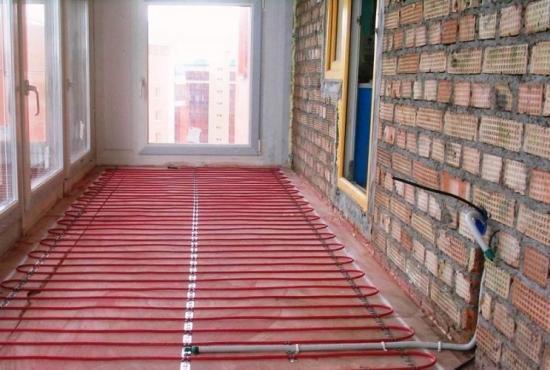

Heating is carried out due to hot water. The downside of this method is the laboriousness of the process. The same electric underfloor heating will be easier to install.
Options for floor insulation on the balcony
In order to make a warm floor on a loggia or balcony, there are currently several proven options. Each of them requires a professional approach and the use of special materials.
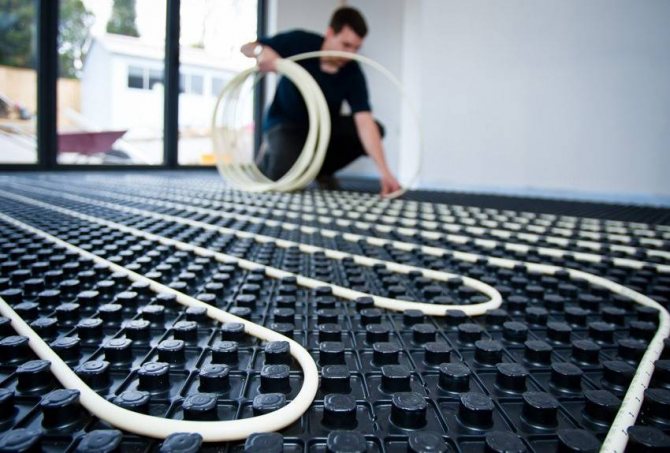

There are several technologies for creating a warm floor.
Common options for underfloor heating:
- water;
- electrical.
The first option is based on a water circuit. Electrical systems use mats, cables and even foil to provide sufficient infrared radiation.
Water heated floor on the balcony: advantages and disadvantages
Among the positive qualities of this system, it should be noted the even distribution of heat over the entire floor area on the balcony. As for the financial costs, they are one-time. You will have to pay for the heated floor only at the stage of its installation. In the course of further operation, the owners of the presented system will significantly save on heating. Another plus is the availability of maximum free space. This is due to the fact that underfloor heating eliminates the need for additional heating radiators and other devices.
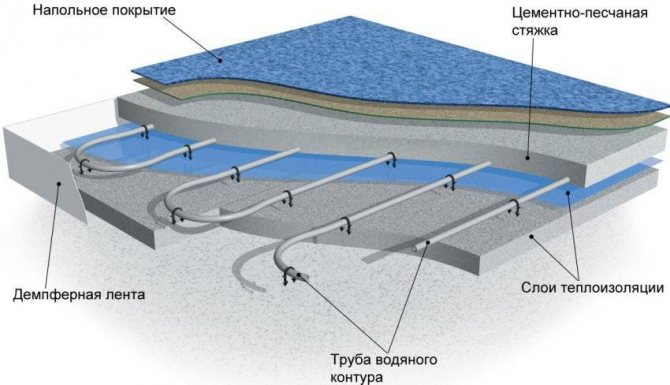

Sectional water underfloor heating
The first drawback that deserves attention is the difficulty of regulating the temperature on the floor surface. And the process of installing the system is very laborious.
It is not very convenient that the pressure in the riser can decrease under certain conditions. To stabilize it, it is periodically necessary to use a water pump. Heating the balcony like this is beneficial until a leak occurs.
Considering the above factors, it can be noted that a water-heated floor is not quite suitable for an apartment in a multi-storey building. In this case, the owners will have to face all of the above problems. A completely different matter is a private house equipped with a separate heating circuit. If you approach the solution of the task professionally, then you can easily achieve a positive result.
Helpful advice! The water version of the underfloor heating can be chosen only due to the fact that it allows you to provide heat to large areas with minimal costs.
Electric underfloor heating on the loggia: pros and cons
An electric floor warms up the surface evenly. Users can easily configure the most optimal temperature regime for themselves. The cost of the presented system is affordable for modern citizens. In the event of any malfunction, it can be repaired quite easily.
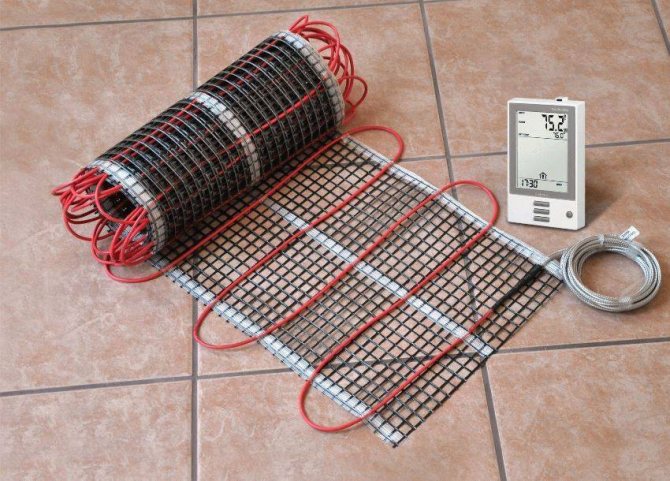

Electric floor is perfect for installation in apartment buildings
It is important for owners of apartments in typical buildings to know that they can easily afford such a system. To carry out installation work, you do not have to use advanced technical equipment
The usual tools found in every home will suffice.
There are also disadvantages to the electric option of a warm floor. However, they are not very significant. The problem may lie in too high electricity tariffs. Such a system will still consume a considerable amount of it.For some citizens, the disadvantage is the presence of electromagnetic radiation.
As a rule, consumers are more likely to prefer the electronic option. Despite the possible overpayment of bills, it attracts the ease of installation and the possibility, if necessary, of repair work. It is not at all necessary to invite specialized specialists to solve such a problem.
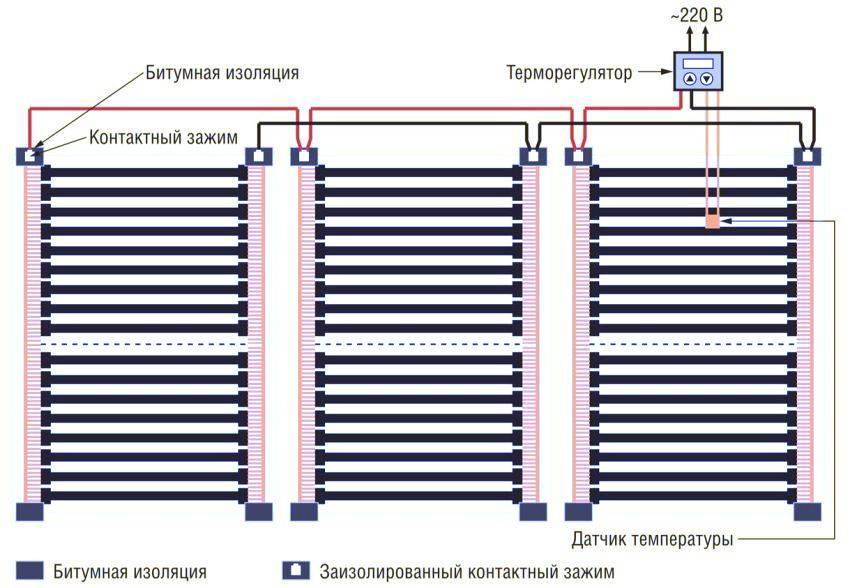

Wiring diagram for connecting floor heating mats
Connection to the heating system
An insert into the central heating riser must be done not only technically competently, but also so that it is invisible to neighbors. Or, at least, so that their living conditions do not deteriorate so much that they turn to judicial protection. How to do it?
Balcony battery
Insert methods
There are two ways to connect to the hydraulic system: serial and parallel. The parallel method is described in the simplest words on one of the construction and repair forums:
With the sequential method, the insertion is carried out at the outlet of the donor battery, and after the additional battery is powered, the pipe extending from it is connected to the “cold” part of the donor battery.
Pros and cons of two types of connections
Connection in parallel with a steam heating radiator behind the wall
With a parallel connection, the cross-section of the water flow to your apartment increases. Exactly the area of the hole through which you supply water to the additional battery. How critical is this?
Let's say you live in a five-story building. The thermal riser lifts hot water from the basement through the radiators of five apartments to the upper floor and descends with its other branch down through five other radiators.
Thus, 10 batteries "sit" on one riser, your additional one will be the 11th. The cross-section of the watercourse will increase by 10%, respectively, the pressure will drop, it will not be difficult to fix such a noticeable value by means of elementary observation of the pressure gauge. If your neighbors have claims against you, then legal showdowns cannot be avoided.
Then the parallel watercourse must be closed, the water from the branch must be drained, the balcony must be used in the mode of an unheated room during frosts. This is the lesser of evils.
More - rupture of pipes will cost a pretty penny.
When an additional heating circuit is connected in series, the total cross section of the water flow does not increase, the pressure in the system does not drop, but this does not mean that the temperature in the neighbors' apartments will not decrease: you are heating your balcony, the coolant loses its calories in this area, and no matter how scanty these losses didn’t seem like they could turn out to be that drop that will overwhelm the capacity of your home's thermal communication to carry loads.
If the front wall is preserved, hang the battery on it!
It is impossible to disconnect the serial connection with one turn of the valve: you will block either the whole riser or a significant part of the circuit connected to it (depending on the general design of the heating system).
Another useful tip: if your balcony is not combined with the room, then attach the battery to the wall on the outside of the front wall.
How do I make a sidebar?
There are two options: welded and threaded.
Balcony water floor
Perhaps, after reading the first part of our article, you are disappointed with the idea of taking central heating to the balcony. In this case, we can offer you other options for heating the balcony. Here you can read about how to arrange a hidden warm water floor on your balcony. For information on how to arrange electric floor heating on a balcony or loggia, read the article "How to independently install an electric floor on a balcony?" Comparison of various options for electric and water (steam) balcony heating is done in the article on our website "Options for heating a balcony or loggia: which is better?"
Using welding
Tapping into a pipe by welding
In the case of using welding on the pipe of the heat riser, a site is prepared. As a rule, a flat area (flat area) is made with a grinder with an emery wheel, leaving a minimum pipe wall thickness.
A branch pipe is welded to this site, on which an additional heating circuit will subsequently be mounted. Reverse insertion is done in the same way.
After welding the nozzles, the outlet and inlet holes in the pipe are made by striking a chisel inserted into these same nozzles. Of course, this should be done in the summer, when the water is drained from the risers.


Drilling a hole in the pipe through the branch pipe
But if you are using ball valves, this operation can be done even if water is flowing through the risers. The sequence is the same, but the hole in the riser is not made with a chisel, but with a drill with a drill attached to it through the hole of an open ball valve.
To prevent the apartment from being flooded with hot water, after drilling the hole, the drill is quickly removed, the ball valve is shut off and the installation of the heating circuit begins.
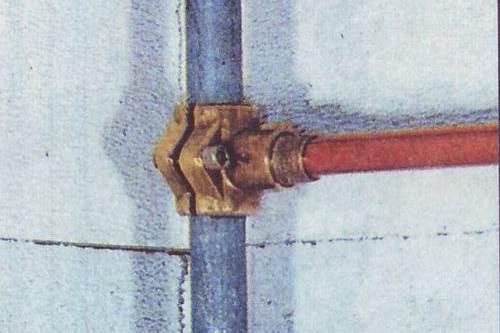

Connection to the pipe with a collar sleeve
In doing so, do not forget about protection. The screen protects the face and the electrical system of the drill from the jet of hot water, which will beat from the riser in those few moments while you take the drill out of the hole made and turn off the tap.
The screen is best made of plexiglass and placed on the front of the drill just behind the rotating head (spindle).
There are options where welding is replaced by the installation of a covering sleeve with a branch pipe, all kinds of clamp mountings; but in any case, it is necessary to either punch or drill holes in the riser.
Using a threaded connection


Sequence of operations for threading near a wall
The threaded insert theoretically looks much simpler: a section of the riser is cut out, a thread is cut at the ends of the riser, onto which a tee is screwed: the balcony branch of the heating circuit will already go from it.
But in practice, both cutting the pipe and tapping it causes significant difficulties. This has to be done near the wall, in a confined space, with the risk of causing such vibrations of the riser, which can lead to the destruction of seals and leakage or breakdown of taps, pipe connections from neighbors.
Tee
Therefore, the work requires the efforts of three or four people: two hold the riser tightly with adjustable wrenches, two more - cut the thread: this operation itself on pipes of this diameter requires great efforts.
Usually, it takes at least an hour and a half to cut 5-6 threads. But in modern houses of high altitude, where pumping stations are used to pump water to the upper floors, a more solid connection is needed, about 10 threads.
Linen thread should be used as a sealant when sealing: the best has not yet been invented.
Modern heating infrared heater for balcony
But fortunately, besides steam heating, there are modern, decent alternatives. You can install a warm floor system or install an infrared heater on the balcony. In the latter case, we are talking about a carbon fiber heater.
Infrared heaters are:
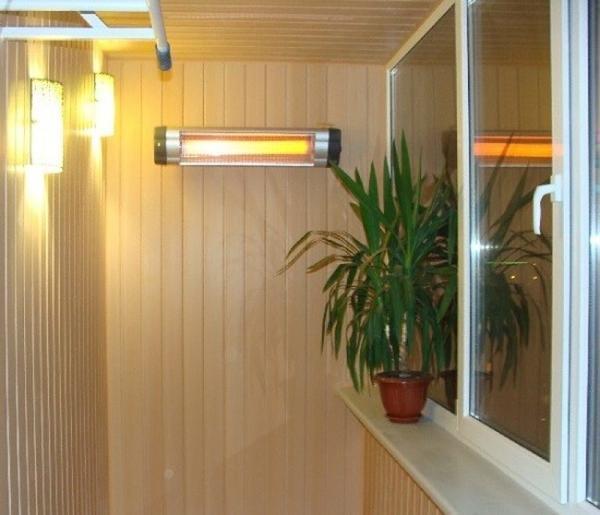

Is such a heater dangerous in an apartment, and even more so a balcony? Infrared rays, one might say, do not have those characteristics that can negatively affect human health. Also, they will not harm animals and plants. They do not create noise and vibrations, and do not burn oxygen in the same way as some other heaters.
It is even believed that this type of radiation allows the creation of molecules in the air called anions. It is believed that they purify the air and have a positive effect on all living things. The power consumption of the infrared heater will save 20 percent. And you can also install a programmable thermostat.And then you can save electricity by all 35%.
Oil heater
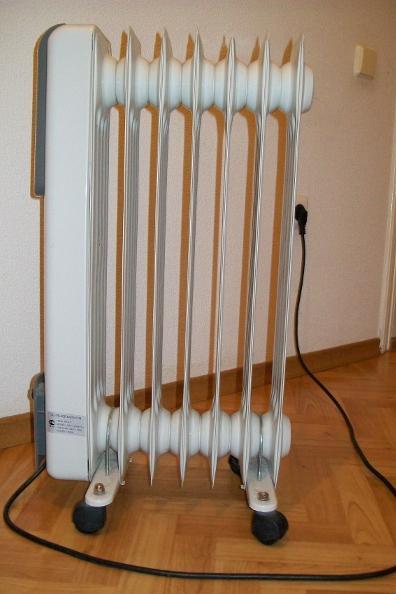

It is convenient to move the oil heater around the balcony on wheels
This is another option for electric balcony heating. The oil heater is a metal case with an electric coil and oil inside.
When the oil temperature reaches 70-80 degrees, the heater turns off. So don't worry about safety! However, as well as for health, because such a heater does not dry the air.
The oil heater has one more feature... It warms up the room rather slowly, and then remains hot for a long time. However, if there are drafts on the balcony, such a heater, unlike other heat sources, will not have time to heat it even for a short time. The heat will dissipate faster than it comes in. Therefore, it is definitely impossible to do without insulation here.
How to choose an IFC terrace heater
Electric infrared heaters for a terrace or balcony emit a directed heat beam that is immediately felt by people in its range. Therefore, heating a terrace with such devices is more efficient, more economical and safer than gas heating.
What to look for when buying
- When choosing a patio heater, the first step is to check the materials from which it was made and whether it is waterproof.
- In addition, it is necessary to check the waterproof class with protection against splashing water from any angle.
- The housing should preferably be made of stainless steel or aluminum with a corrosion-resistant coating.
- Choose all-weather IFC heaters.
Do you not know what power the heater should choose for your terrace? Here are some tips for choosing a radiator.


How many meters of terrace do you want to heat
Remember that there is usually no need to fully heat the deck. This is why it doesn't matter how big your terrace is.
More importantly, which dedicated area on the terrace (surface) you want to heat. Think about where you usually stay: sofa, table with chairs? For example: if this is an area at the table, and your entire terrace has an area of 50 sq.
M, then it is enough to heat about 10 sq. M of terrace area. Because the surface of a table with chairs rarely occupies more than 9 m2.
